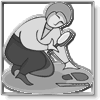3.2 Reading Projects-Unit 3
Criteria for Your Zeef Page
Date
Find and Evaluate the Date
Before information is used or cited, it is important to find out how old it is and if that makes a difference.
The date of an online article or the last time a Web page was modifed is not always possible to find. Depending on the nature of the information and its purpose, being confident that it is recent enough for current events or old enough accurately to reflect historical perspectives can be vitally important.
from: https://21cif.com/rkitp/course/twohourworkshop/datefind.html
Techniques to locate the date
Here is an example of a page where the date is not clearly identified:
Use these techniques to locate date information:
If looking at the top or bottom of the page doesn't immediately reveal a date, look in columns, headings, captions--anywhere such a detail could hide. Authors don't always put the date in predictable places.
Sometimes the last date a page was modified can be determined by right clicking the page and selecting 'View Page Info' (in Firefox) or 'Properties' (in IE). This doesn't necessarily mean the article was authored on this date--just that something on the page was modified then. If the information provided is very recent (seconds ago) it indicates code that automatically updates page information whether the author changed it or not.
If you can't spot "last updated" information on the page, replace the url with this code and hit enter: javascript:alert(document.lastModified) If page update information is available, this will return it. If not, the time stamp when you hit enter will likely be returned.
Search Google, etc. using the title of the article to see if other extant copies include a date.
If it is critical that a historical date be established, consider searching archive.org for saved copies of the page to determine when changes to a page were made. This requires reading and comparing documents.
from https://21cif.com/rkitp/course/twohourworkshop/datefind_help.html
